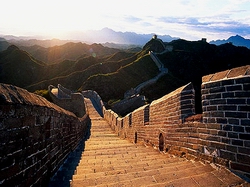 Setting out from Beijing, the most popular destination for visiting the Great Wall is Badaling. Both trains and buses go to the northwest of the city proper in a deep mountain-flanked gully 15 kilometers long. In summer, the peaks here are covered with brilliant stretches of leaves and luxuriant flowers.
Setting out from Beijing, the most popular destination for visiting the Great Wall is Badaling. Both trains and buses go to the northwest of the city proper in a deep mountain-flanked gully 15 kilometers long. In summer, the peaks here are covered with brilliant stretches of leaves and luxuriant flowers.
The Badaling Great Wall locates the northwest of the Beijing, its position is longitude 116 degrees 65 cents east and latitude 40 degrees 25 cents north, it's a pass of Jundu mountain. It extends in all directions which is the reason it be called Badaling.
In the Yuan Dynasty, it was called as "North mountain pass", which is comparative to the "South mountain pass". The South mountain pass locates in the Changping county, between them is a gorge which extends 20 kilomitres and be called "Juyong Gate", this gorge is called "GuanGou". The Badaling Great Wall locates on the ridge of the northern part of the GuanGou. Here, Two peaks face to face, there is a alley between them two, it's a very strategic place. Look down the JuYong Gate from the Badaling, it looks like a well. The ancients said "The risk of The JuYong Gate is not the Guan city, but the Badaling". Because of the importance of the Badaling, it has being the place that the military fight against for.
Badaling is the highest point along the entire length of the Great Wall. Between Badaling and Juyong Pass, two Chinese characters Tianxian (Natural Barrier) are carved into a steep and imposing cliff. During the Ming Dynasty, two fortifications were built in this area, the Northern Gate Pass on west and the Juyong Garrison on the east. By climbing up through the pass and looking westward, one will be able to see a chain of mountains stretching away to the horizon with a single defile leading through them. To the north of the ridges near the wall is the platform for Viewing the Capital (Wangjingtai) and on clear days the White Dagoba in Beijing Park can be seen from here. By climbing over another slope and following a flight of stone steps up to the highest point of the southern section of the wall, one can see the dragon-like Great Wall making its way over the mountains.
Strategic platforms were built every 300 to 500 meters along the wall. These platforms served a variety of purposes: for posting patrols and sentries; to serve as observation posts; and as battle platforms for offensive actions and weapon storage. Here there are also reinforcing walls built alongside the wall proper and beacon towers for transmitting military information.
The Badaling section of the Great Wall most frequented by visitors dates from the Ming Dynasty. Constructed of large blocks of granite and bricks, the wall at this point is 6.6 meters high and 6.5 meters wide at its base, narrowing to 5.5 meters on the rampart. It is wide enough to permit five or six horses to stand abreast.
In recent years, the Chinese government has carried out restoration work on the sections of the wall which have collapsed or been eroded by wind and sand. Despite this, the great increase in tourists at the Great Wall in recent years has led experts to suggest the opening of a "second Badaling" to accommodate the great number of visitors. The "second Badaling" is located to the northeast of Beijing proper and can be reached by bus in approximately two hours. Built on the Great and lesser Gold mountains (Jinshan), this section is also called the Gold Mountain Great Wall. According to historical records, the construction of this part of the wall was begun in 1571, and is part of the 1,000-kilometer-long section of the wall between the Shanhai Pass in the east and Changping County in the west, which was the result of cooperation between two famous Ming generals, Qi Jiguang and Tan Lun. In terms of construction it is in no way inferior to the wall at Badaling.


 About Beijing
About Beijing 



